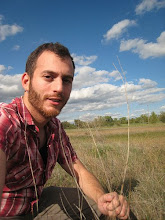Up until 1961, the Pacific Electric Red Car took commuters from Orange County and Long Beach to downtown LA. With the demise of public transit in SoCal, the rights-of-way lay fallow for decades. In 1999, the City of Long Beach decided to convert most of the land to recreational park lands, the Long Beach Greenbelt. However, one short block on the right-of-way, bewteen 7th and 8th streets, was set aside for native habitat restoration.
This part of the greenbelt is very small (under 5 acres). Although it is owned by the Long Beach Parks Department (woefully out-of-date park info page), it is managed by the Los Cerritos Wetlands Stewards.
The target habitat in this park is coastal sage scrub, once the dominant habitat type in this part of the coastal plain. Coastal sage scrub is dominated by short vegetation that generally loses its leaves in the winter, unlike the evergreen chapparal. The loss of leaves allow coastal sage scrub to fluorish in areas too dry for chapparal, such as the low elevation coast.
The habitat restoration makes extensive use of one of the staple plants of the coastal sage-scrub: California buckwheat (Eriogonum fasciculatum).
This plant blooms throughout much of the year and forms very attractive shrubby mounds.
Sage is, of course, another common plant in coastal sage scrub:
Black sage (Salvia mellifera)
Other flowers that you can expect to see any time of year include the bizarre bladderpod (Isomeris arborea):
Other "pretty flowers" to look for:
Ceanothus (Ceanothus sp.)
Deerbush (Lotus scoparius)
Matilija poppy (Romneya coulteri)
Island mallow (Lavatera assurgentiflora)
Heartleaf penstemon (Keckiella cordifolia)
California poppy (Eschscholzia californica)
The restoration included a few trees to create patches of woodland habitat, just for good measure:
Coast live oak (Quercus agrifolia)
California walnut (Juglans californica)
Blue elderberry (Sambuccus mexicana)
The diversity of tree and shrub habitats make this tiny park a good home for birds and small mammals.
I don't know if there is room to expand the restoration area. The remainder of the greenbelt is (in my view) unremarkable:
These areas seem to be heavily used by dog-walkers, a few of whom do not clean up after themselves. Some common invasive plants were found growing outside the greenbelt, closer to Colorado Lagoon:
Giant Reed (Arundo donax):
Ice plant (Carpobrotus edulis):
Wild radish (Raphanus sativus):
The park is suitable for walking, running, or cycling (sturdy bikes only).
LB Transit bus lines #81, 91, 92, 93, and 94 will take you to the Long Beach Greenbelt. Also the OCTA #60 goes down 7th Street.
Further information:
Wikipedia
EPA (which funded the creation of the park).

No comments:
Post a Comment